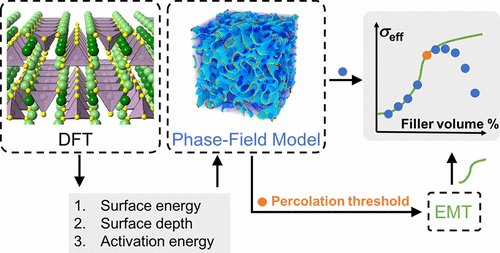当前位置:
X-MOL 学术
›
ACS Appl. Mater. Interfaces
›
论文详情
Our official English website, www.x-mol.net, welcomes your feedback! (Note: you will need to create a separate account there.)
Phase-Field Based Multiscale Modeling of Heterogeneous Solid Electrolytes: Applications to Nanoporous Li3PS4
ACS Applied Materials & Interfaces ( IF 9.5 ) Pub Date : 2017-09-18 00:00:00 , DOI: 10.1021/acsami.7b11292 Jia-Mian Hu 1 , Bo Wang 1 , Yanzhou Ji 1 , Tiannan Yang 1 , Xiaoxing Cheng 1 , Yi Wang 1 , Long-Qing Chen 1
ACS Applied Materials & Interfaces ( IF 9.5 ) Pub Date : 2017-09-18 00:00:00 , DOI: 10.1021/acsami.7b11292 Jia-Mian Hu 1 , Bo Wang 1 , Yanzhou Ji 1 , Tiannan Yang 1 , Xiaoxing Cheng 1 , Yi Wang 1 , Long-Qing Chen 1
Affiliation

|
Modeling the effective ion conductivities of heterogeneous solid electrolytes typically involves the use of a computer-generated microstructure consisting of randomly or uniformly oriented fillers in a matrix. However, the structural features of the filler/matrix interface, which critically determine the interface ion conductivity and the microstructure morphology, have not been considered during the microstructure generation. Using nanoporous β-Li3PS4 electrolyte as an example, we develop a phase-field model that enables generating nanoporous microstructures of different porosities and connectivity patterns based on the depth and the energy of the surface (pore/electrolyte interface), both of which are predicted through density functional theory (DFT) calculations. Room-temperature effective ion conductivities of the generated microstructures are then calculated numerically, using DFT-estimated surface Li-ion conductivity (3.14 × 10–3 S/cm) and experimentally measured bulk Li-ion conductivity (8.93 × 10–7 S/cm) of β-Li3PS4 as the inputs. We also use the generated microstructures to inform effective medium theories to rapidly predict the effective ion conductivity via analytical calculations. When porosity approaches the percolation threshold, both the numerical and analytical methods predict a significantly enhanced Li-ion conductivity (1.74 × 10–4 S/cm) that is in good agreement with experimental data (1.64 × 10–4 S/cm). The present phase-field based multiscale model is generally applicable to predict both the microstructure patterns and the effective properties of heterogeneous solid electrolytes.
中文翻译:

基于相场的非均相固体电解质多尺度建模:在纳米多孔Li 3 PS 4中的应用
对异质固体电解质的有效离子电导率进行建模通常涉及使用计算机生成的微结构,该微结构由基质中无规或均匀取向的填料组成。但是,在微观结构生成过程中并未考虑填充物/基体界面的结构特征,该结构特征决定了界面离子电导率和微观结构形态。使用纳米多孔β-李3 PS 4以电解质为例,我们开发了一个相场模型,该模型能够根据表面的深度和能量(孔/电解质界面)生成不同孔隙率和连通性图案的纳米多孔微结构,这两者都是通过密度泛函理论预测的( DFT)计算。然后,使用DFT估算的表面锂离子电导率(3.14×10 –3 S / cm)和实验测得的整体锂离子电导率(8.93×10 –7 S / cm)对生成的微结构的室温有效离子电导率进行数值计算。厘米)β-李的3 PS 4作为输入。我们还使用生成的微结构来告知有效的介质理论,以通过分析计算快速预测有效的离子电导率。当孔隙率接近渗流阈值时,数值和分析方法都可以预测锂离子电导率显着提高(1.74×10 –4 S / cm),这与实验数据(1.64×10 –4 S / cm)非常吻合。基于本发明的基于相场的多尺度模型通常可用于预测微观结构模式和非均相固体电解质的有效性质。
更新日期:2017-09-18
中文翻译:

基于相场的非均相固体电解质多尺度建模:在纳米多孔Li 3 PS 4中的应用
对异质固体电解质的有效离子电导率进行建模通常涉及使用计算机生成的微结构,该微结构由基质中无规或均匀取向的填料组成。但是,在微观结构生成过程中并未考虑填充物/基体界面的结构特征,该结构特征决定了界面离子电导率和微观结构形态。使用纳米多孔β-李3 PS 4以电解质为例,我们开发了一个相场模型,该模型能够根据表面的深度和能量(孔/电解质界面)生成不同孔隙率和连通性图案的纳米多孔微结构,这两者都是通过密度泛函理论预测的( DFT)计算。然后,使用DFT估算的表面锂离子电导率(3.14×10 –3 S / cm)和实验测得的整体锂离子电导率(8.93×10 –7 S / cm)对生成的微结构的室温有效离子电导率进行数值计算。厘米)β-李的3 PS 4作为输入。我们还使用生成的微结构来告知有效的介质理论,以通过分析计算快速预测有效的离子电导率。当孔隙率接近渗流阈值时,数值和分析方法都可以预测锂离子电导率显着提高(1.74×10 –4 S / cm),这与实验数据(1.64×10 –4 S / cm)非常吻合。基于本发明的基于相场的多尺度模型通常可用于预测微观结构模式和非均相固体电解质的有效性质。



























 京公网安备 11010802027423号
京公网安备 11010802027423号